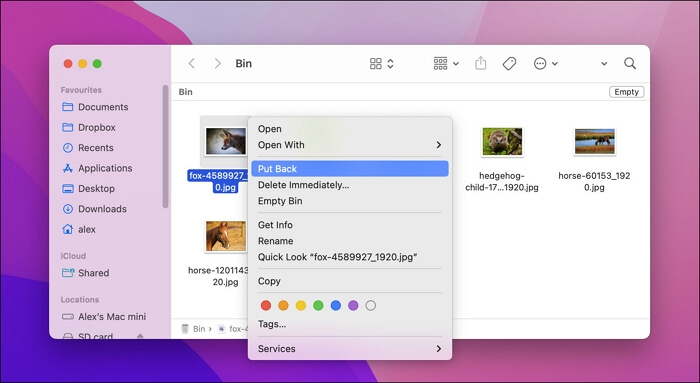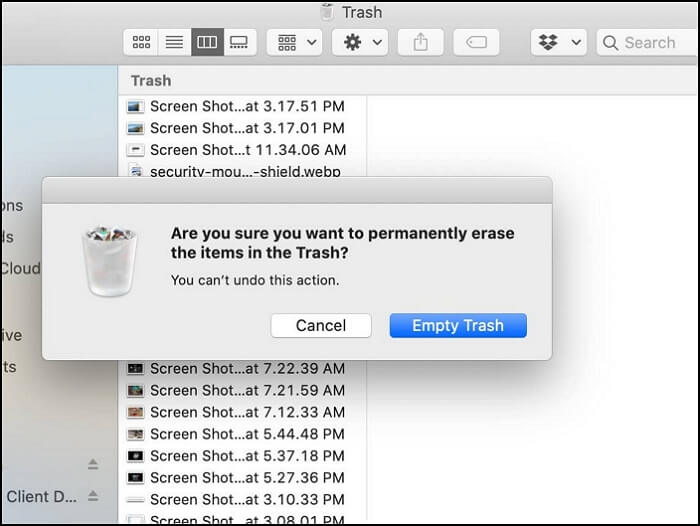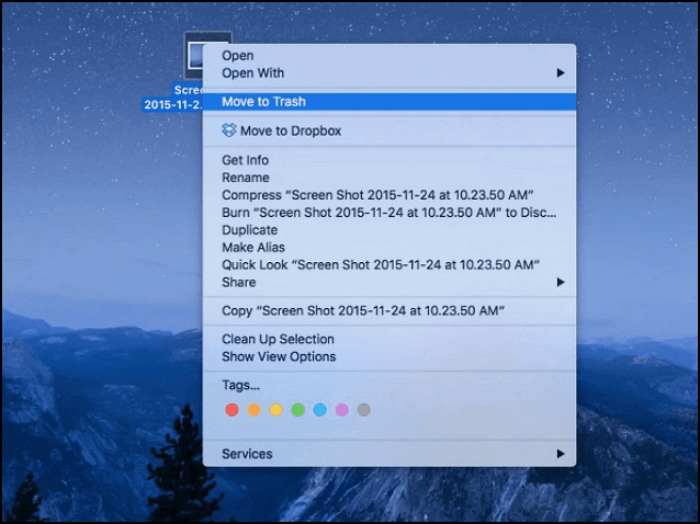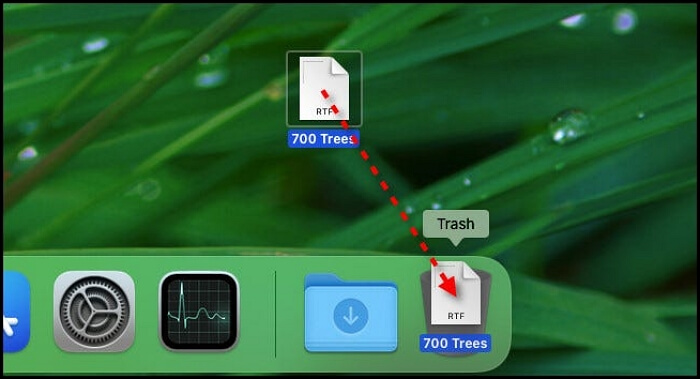Why Should I Move Files to Trash on Mac with Shortcut
As a Mac user, you may wonder where to put the files and folders you don't need and make your desktop look organized. There is one place you can store these unwanted files and folders – Trash on Mac.
You can move files to Trash in common ways or with the shortcut. Move files to Trash on Mac with a shortcut is fast, and you can move any selected items to Trash in one second. If you have many unwanted files on your desktop, you will know how to deal with them and how to empty Trash on Mac by reading this passage. Share this post on Facebook, Twitter, or other social media you usually use in case you want to reread it.
We will introduce move to Trash shortcuts on Mac, and here is a video about moving to Trash shortcuts on Mac. You can check the important moments first:
- 00:10 How to delete files on Mac
- 01:02 How to put back the files on Mac
- 01:53 Remove the items from the Trash
- 02:01 The warning before emptying the Trash
How to Recover Deleted Files from Trash on Mac (2 Ways)
Before you empty the Trash on Mac, the files and folders in Trash can be recovered directly. If you have emptied the Trash, you can still recover files with recovery software.
How to Recover Temporarily Deleted Files in Trash on Mac
We have mentioned you can put unwanted files and folders in Trash if you change your mind, and you can recover them with one click.
Step 1. Find the file or folder you want in the Trash.
Step 2. Right-click the file and choose "Put Back".

Step 3. Then you can find this file in the original position.
How to Recover Permanently Deleted Files from Emptied Trash on Mac
After you empty the Trash, you may want to return some deleted files. A magic recovery tool can help you recover deleted files from emptied Trash on Mac. EaseUS Data Recovery Wizard for Mac is a valuable tool focused on Mac data recovery.
You don't have to worry about how to recover Trash Mac or how to recover SD card Mac with this reliable tool. EaseUS Data Recovery Wizard for Mac can help you recover accidentally deleted files, recover permanently deleted files Mac, recover unsaved Word document Mac and recover deleted videos or photos.
You will need only three steps to recover deleted files and folders from emptied Trash on Mac.
Step 1. Select the drive to be scanned
In the main EaseUS Data Recovery Wizard window, there will be a list of the drives connected to your Mac. Select the drive you need to recover lost/deleted files from, and click the "Search for lost files" button.

Step 2. Select your lost data/files
EaseUS Data Recovery Wizard for Mac will immediately scan your selected disk volume and display the scanning results on the left pane. You can sort the results to find the wanted files if you are looking for certain files.

Step 3. Recover lost/deleted data
Once you have found the desired files, preview the files and then click "Recover" to begin the recovery of your deleted/lost Mac files.

Move to Trash Shortcut(Three Ways)
Do you know where is the Trash on Mac? With so many icons on the Mac desktop, you can find the trash icon on the desktop like this:
![]()
Moving files and folders to Trash is not complex, and there are three sets of shortcuts you can use to delete files to Trash.
Move Files to Trash Bin Shortcut - Command + Delete
This method may be the easiest way to move files to Trash. You can press keys on your keyboard to delete files and folders.
Step 1. Select all the unwanted files and folders.
Step 2. Press both the Command and Delete buttons.

Step 3. If the files are locked, click "Continue" to confirm.
Step 4. All the files you delete will be kept in Trash.
Empty Trash on Mac Shortcut - Command + Shift + Delete
Keeping deleted files and folders in the Trash for a long time is not a good idea. It will take up space on your Mac, and your Mac device may get slower as time goes by. The Trash on Mac will be emptied automatically every 30 days. If your Trash deletes files immediately, you can stop Trash deleting files immediately on Mac. You don't have to open the Trash and click to empty your Trash on Mac, and you can empty Trash on Mac quickly with the shortcut.
Step 1. You don't have to select any files. Just hold Command + Shift + Delete.
Step 2. With this method, you may be asked to confirm.
Step 3. If you are sure you want to erase all the files, just click "Empty Trash".

Empty Trash on Mac Shortcut Without Confirm
If you don't want to confirm your intention and empty the Trash on Mac, you will need to press four keys at the same time. Press Command + Shift + Option + Delete, then your Trash can be emptied without a confirmation dialog box.
Be careful with this method because your files and folders in the Trash will be deleted permanently once you press the four keys.
Note: If you can't empty the Trash on Mac, don't panic. Click the anchor text to fix it.
Common Ways to Move to Trash on Mac
After learning to move files to Trash with shortcuts, you may want to know the common ways. We will teach you moving files to Trash in two common ways.
Method 1. Move Files to Trash Bin with Right-click
We will introduce the most common way to delete files and folders on Mac. Follow these steps:
Step 1. Right-click the item you want to delete, and it will turn blue.
Step 2. You will see the active list of this item. Choose "Move to Trash".

Step 3. It will immediately move to Trash, and you can check or restore it from Trash.
Method 2. Move Files to Trash Bin by Dragging
You have learned the most common way to move files to Trash on Mac. Then we will teach you a fast manner.
Step 1. Select the files and folders you want to delete.
Step 2. Drag them to the Trash on Mac.

Step 3. Then you can find these deleted files and folders in Trash.
Bonus Tips: How to Fix Move to Trash Shortcut Mac Not Working
If you want to move files to Trash and sadly find your shortcuts not working. Try the following solutions:
Tip 1. Look into System Preferences and make sure Command is enabled and mapped to the Cmd key.
Tip 2. Check the custom shortcuts in the Keyboard Shortcut panel.
Tip 3. Check in the Finder, right-click a file, and see what shortcut is associated to "Move to Trash".
Conclusion
With the detailed guide, we hope you have learned to move to Trash shortcuts on Mac. You can hold Command and Delete to move files to Trash, and pressing Command + Shift + Delete and Command + Shift + Option + Delete can help you empty the Trash on Mac. Don't forget to download EaseUS Data Recovery Wizard for Mac if you need to recover data one day. No matter what you want to recover, EaseUS Data Recovery Wizard for Mac can greatly help you.
Move to Trash Shortcut on Mac FAQs
Do you have further questions? Find answers here:
How do I move multiple items to Trash on Mac?
You can open the folder containing the files you wish to select first and hold Command on your keyboard while left-clicking each file and then dragging them to the Trash.
What is the shortcut to delete a file on Mac?
Command and Delete are the delete keys on Mac. You can move unwanted files and folders to Trash by pressing both Command and Delete buttons. If you want to empty the Trash, try Command + Shift + Delete and Command + Shift + Option + Delete.
How do you get to the Trash Bin on a Mac?
The Trash Bin can be found on the desktop on Mac commonly. And you can use the Terminal and search function to find your Trash Bin on Mac.
How do you Delete files without the Delete button on a Mac?
You can delete files with shortcuts. Hold Command and Delete can move files to Trash, and Command + Shift + Delete and Command + Shift + Option + Delete can help you empty the Trash on Mac.
Was This Page Helpful?
Dany is an editor of EaseUS who lives and works in Chengdu, China. She focuses on writing articles about data recovery on Mac devices and PCs. She is devoted to improving her writing skills and enriching her professional knowledge. Dany also enjoys reading detective novels in her spare time.
-
EaseUS Data Recovery Wizard is a powerful system recovery software, designed to enable you to recover files you’ve deleted accidentally, potentially lost to malware or an entire hard drive partition.
Read More -
EaseUS Data Recovery Wizard is the best we have seen. It's far from perfect, partly because today's advanced disk technology makes data-recovery more difficult than it was with the simpler technology of the past.
Read More -
EaseUS Data Recovery Wizard Pro has a reputation as one of the best data recovery software programs on the market. It comes with a selection of advanced features, including partition recovery, formatted drive restoration, and corrupted file repair.
Read More
Related Articles
-
Missing Photos After macOS Sequoia Update, How to Recover Safely?
![author icon]() Dany/Dec 12, 2025
Dany/Dec 12, 2025 -
How to Permanently Delete Downloads on Mac to Clear Up Space [macOS Ventura/Monterey/Big Sur]
![author icon]() Jaden/Dec 12, 2025
Jaden/Dec 12, 2025 -
How to Find External Hard Drive on Mac In Case It's Working but Not Showing Up
![author icon]() Jean/Dec 12, 2025
Jean/Dec 12, 2025 -
Solved: How Can I Stop Trash Deleting Files Immediately on Mac
![author icon]() Jean/Dec 12, 2025
Jean/Dec 12, 2025